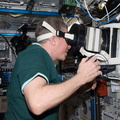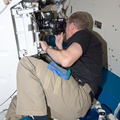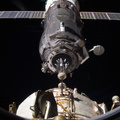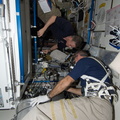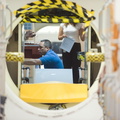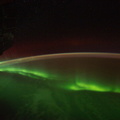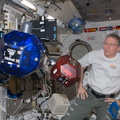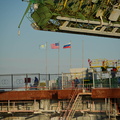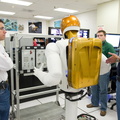
WIKIARCHIVES.SPACE
The Human Spaceflight Archive

Crepuscular rays near India are featured in this image photographed by an Expedition 29 crew member on the International Space Station. The sight of shafts of light, beaming down from the heavens through a layer of clouds, has provided many an artist, scientist, and philosopher with inspiration throughout the centuries. Atmospheric scientists refer to this phenomenon as "crepuscular rays", referring to the typical observation times of either sunrise or sunset. Shadowed areas bounding the rays are formed by obstructions in the solar (or lunar) illumination pathway such as clouds or mountain tops; however this alone is not sufficient to create the phenomenon. The light must also be scattered -- by airborne dust, aerosols, water droplets, or molecules of the air itself—to provide the visible contrast between the shadowed and illuminated parts of the sky. When observed from the ground, crepuscular rays appear to radiate outwards from the source of illumination due to the effects of distance and perspective; however the rays are actually parallel. This photograph from the space station provides an unusual viewing perspective from above the rays. The sun was setting to the west on the Indian subcontinent at the time the image was taken, and cumulonimbus cloud towers provide the shadowing obstructions. The rays are being projected onto a layer of haze below the cloud towers. The image clearly illustrates the true parallel nature of the crepuscular rays.
Information
- Taken in
- Space
- Autor
- NASA
- Descripción
-
Crepuscular rays near India are featured in this image photographed by an Expedition 29 crew member on the International Space Station. The sight of shafts of light, beaming down from the heavens through a layer of clouds, has provided many an artist, scientist, and philosopher with inspiration throughout the centuries. Atmospheric scientists refer to this phenomenon as "crepuscular rays", referring to the typical observation times of either sunrise or sunset. Shadowed areas bounding the rays are formed by obstructions in the solar (or lunar) illumination pathway such as clouds or mountain tops; however this alone is not sufficient to create the phenomenon. The light must also be scattered -- by airborne dust, aerosols, water droplets, or molecules of the air itself—to provide the visible contrast between the shadowed and illuminated parts of the sky. When observed from the ground, crepuscular rays appear to radiate outwards from the source of illumination due to the effects of distance and perspective; however the rays are actually parallel. This photograph from the space station provides an unusual viewing perspective from above the rays. The sun was setting to the west on the Indian subcontinent at the time the image was taken, and cumulonimbus cloud towers provide the shadowing obstructions. The rays are being projected onto a layer of haze below the cloud towers. The image clearly illustrates the true parallel nature of the crepuscular rays.
- Creada el
- Martes 18 Octubre 2011
- Albumes
- ISS (WIP) / EXPEDITIONS / EXPEDITION 29
- Source link
- https://www.flickr.com/photos/nasa2explore/albums/72157627462367306
- Visitas
- 19
- Valoración de resultados
- sin calificar
- Votar esta foto
- License
- CC BY-NC-ND
- Modified by WikiArchives
- No (original)
- Descargas
- 0
Metadatos EXIF
NIKON CORPORATION NIKON D2Xs
- Make
- NIKON CORPORATION
- Model
- NIKON D2Xs
- DateTimeOriginal
- 2011:10:18 11:32:53
- ApertureFNumber
- f/3.8
Puesto en página por Piwigo


































































































